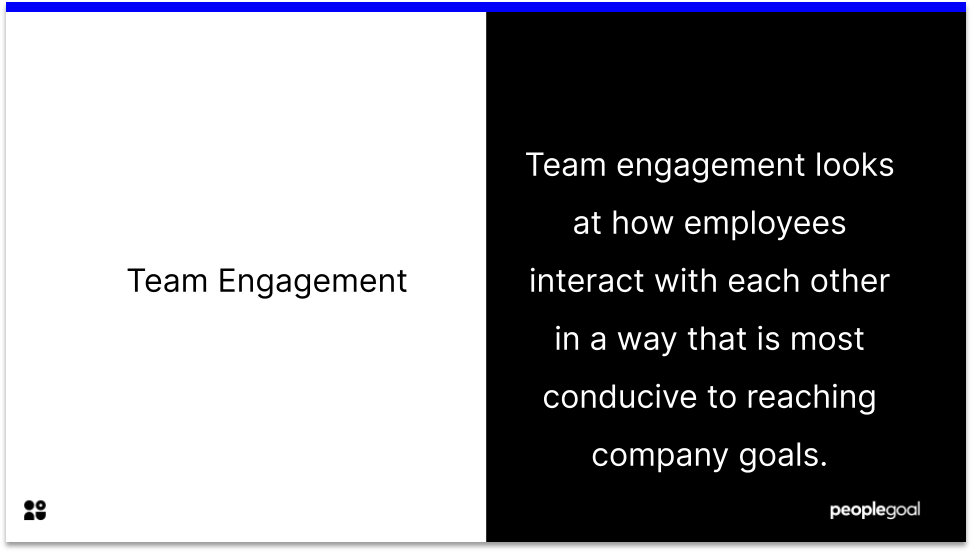Micromanagement is often perceived as a disruptive practice used by employers to track performance and maintain control within an organization. There are cases where such practices threaten mental health and trigger burnouts. However, there are components of micromanagement that can boost employee performance and productivity. Company culture and a healthy work environment are integral to an organization and managers should adapt their leadership styles to enhance this.
What is Micromanagement?
Micromanagement is a management style where a manager closely observes and controls the work of their employees. Micro-managers often focus on the small details of projects rather than look at the big picture. They struggle to delegate work involving decision-making.
Micromanaging is very common. Harry Chambers, the owner of Trinity Solutions, found that 79% of people have experienced micromanagement at some point in their careers. This can happen both in-office or whilst remote working.
Often, micromanagers rely on inducing fear into their employees which can create a toxic company culture and work environment. However, this is not always the case. Micro-managers can also provide guidance and support.

What are the Signs of Micromanagement?
The micromanager style of leadership affects productivity, employee retention, morale, performance, and health. The following are signs of a micro-manager boss:
- Needs to be copied into every email
- Only offers One-way Feedback
- Feedback is only negative (not constructive)
- Only the manager can make decisions
- Suggests unrealistic deadlines
- Never satisfied with deliverables
- Quick employee turnover
- More time is spent overseeing tasks than completing them
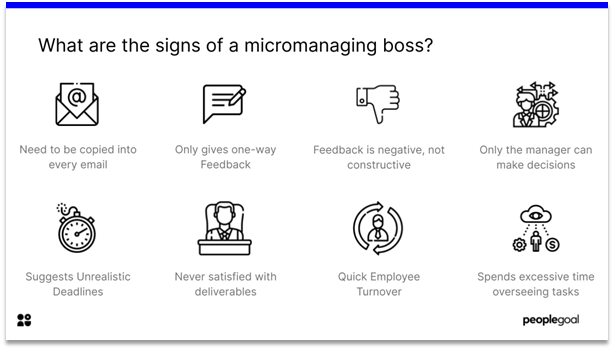
Why do People Micro-Manage?
Often, micro-managers have good intentions and consider their management style to be structured, organized or perfectionistic. Such people may be detail-orientated, under severe time and performance pressure, or genuinely concerned about an employee’s competence.
Other managers feel that this form of management enables them to feel close to their team as they are all regularly in contact. Gallup found that although employees value receiving feedback, 19% of employees receive this from their managers once a year or less. Micromanagement can improve this.
Forbes report that 41% of leaders have a strong desire for power. Some micro-managers fear that employees will tarnish their reputation and destabilize their position of power.

Why does Micromanagement have Negative Connotations?
Micromanagement often has negative connotations in Human Resources Management. Many employees feel this form of business management is annoying as they cannot work independently and there is a lack of trust within an organization. It can be counter intuitive as the desire to control everything creates long term issues as employees must navigate dealing with a micromanaging boss.
Effects on Employees
Employees dislike micromanagement because it stifles their creativity. People feel they can no longer share their opinions nor work autonomously.
When managers believe that no one is capable of a task, employees begin to doubt themselves and distrust those around them. This resentment results in a hostile work environment and can cause workplace bullying.
Micromanagement negatively affects employees’ self-esteem and mental health. By ignoring employees experience and opinions, employees lose self-confidence. This may further cause anxiety, depression or even a burnout. Harry Chambers discovered that 32% of people have changed jobs following micromanagement in the workplace.
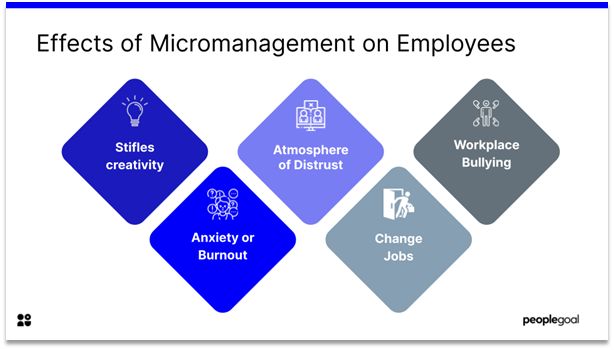
Effects on Organizations
The increased stress on employees increases rates of employee turnover which eventually becomes a cost for organizations. There are lost opportunities where highly skilled employees leave and move to work for competitors. They may speak about why they left and damage a company’s reputation.
Micromanagement reduces communication between employees. This delays decisions and clouds overall goals and objectives.
Overall, micromanagement can create an environment that threatens employee engagement and lower team morale.
What are the Advantages of Micromanagement?
Managers are highly involved and engaged with all employees. This ensures they can get the best out of their team by allocating tasks to those with the most relevant skillsets.
Managers are aware of what everyone is doing and can obtain more accurate metrics. It is easier to build a stronger sense of a team’s efficiency and performance.
Micromanagement can be adapted to assist an employee working from home. It ensures everybody is connected within a team and on track to meet collective goals and objectives.
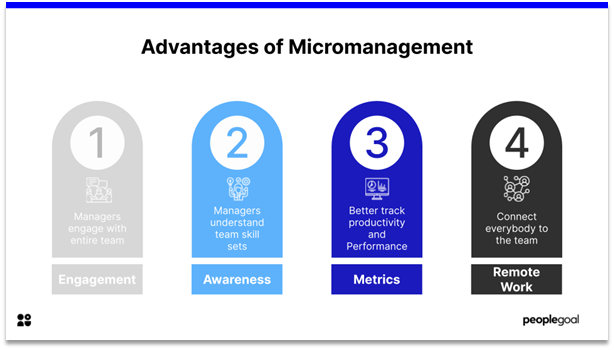
When can Micromanagement be Effective?
Micromanagement can be effective when applied appropriately throughout onboarding, in smaller teams, and throughout complex projects.
Onboarding
Micromanagement can help onboard employees and help new hires get up to speed. Regular communication with new employees ensures that they understand their role within the team and the wider organization. Employers can track their progress and train them to complete procedures in the required manner.
Check Out our Onboarding Apps to strengthen your HR 👈
Smaller Teams
Within a smaller team or organization, micromanagement can be key. Managers are aware of every team member’s strengths and weaknesses. This is integral to allocating the appropriate tasks to each member and delegating efficiently.
Furthermore, there is regular communication between employees and the company culture becomes collaborative and more inclusive.
Complex Projects
Complex projects may have numerous components. It is useful for a project manager to know who is doing what and when this will be completed. Micromanagement on such projects ensures that deadlines are met on time and that all aspects of a project are delivered to a high standard.
Micromanagers ensure that everyone is contributing within a high performing team.
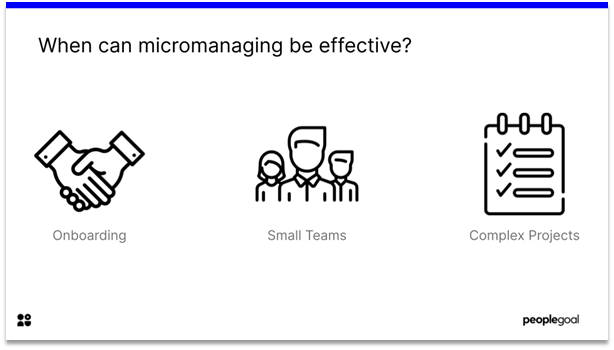
How to Make Micromanaging Positive for Everyone
Evidently, excessive micromanagement is detrimental to both employee health and organization productivity. However, micromanaging practices can be adapted to maximize performance and create a healthy company culture which promotes communication and performance management.
To improve micromanagement, managers should first delegate more tasks. When assigning these, they should not give detailed instructions to allow an employee to complete the work as they see fit.
Having said this, employees should have clearly defined goals and objectives so that they are aware of what they need to achieve and can perform accordingly.
There are tools that reduce admin, improve productivity and efficiency. Task management software can allocate tasks and help managers track employee progress. It is more important to focus on key results rather than the amount of time people clock in.
💡 If you have identified a micromanager, speak to them and approach the topic respectfully. 360 feedback is always beneficial.
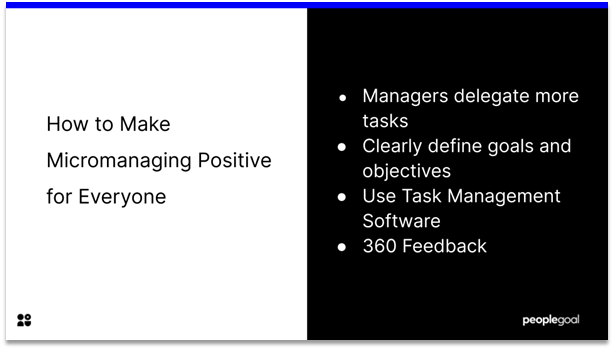
To Sum Up
Micromanagement is where managers closely supervise and control an employee’s work. Although this is often perceived negatively, there are elements of this management technique that can greatly benefit organizations and their employees, if not used excessively. Managers should delegate tasks, track employee performance, and promote a healthy work environment.
Micromanagement is especially helpful when onboarding new employees, working in small teams, and when conducting a complex project. There are numerous ways to adapt micromanagement practices to maximize employee performance and support their wellbeing.
Ready to 3x Your Teams' Performance?
Use the best performance management software to align goals, track progress, and boost employee engagement.





